By Andres Cala, Energy Tribune
Spain is planning to correct its renewable energy experiment gone wrong by spreading the pain, a powerful lessons for a White House with an incoherent energy policy that has often cited its model as one to emulate.
This week Obama’s campaign bashed challenger Mitt Romney for planning to end tax incentives for wind power if elected. “By opposing an extension to the wind production tax credit, Mitt Romney has come out against growth of the wind industry to support 100,000 jobs by 2016 and 500,000 jobs by 2030.”
Obama’s expectations though are based on European policy support models that are being revised and corrected. Ahead of November elections, both candidates must realize America’s energy policy more than ever demands a coherent policy based on its best interest not ideological imperatives.
Putting renewable on steroids can come to damage a country’s power sector, consumers, and the renewable industry itself, and in Spain’s case, even a national economy.
Public support for renewable power in America thus should be reconfigured to achieve realistic economic or geopolitical net gain, not winning elections.
During the first two years of his administration, President Barack Obama and top officials praised Spain as a successful model to create employment and improve energy security. So did everyone else, for that matter, but it’s time to heed the lessons.
For over a decade Spain has accumulated nearly 25 billion euro in debt –equivalent to more than half of the urgent capitalization needs of its distraught financial system- mostly in the form of subsidies for wind and solar energy.
Basically the country did not pass along to consumers the cost of generating around 30 percent of its electricity through renewable sources, and faced with the prospect of a macroeconomic sovereign collapse it has decided to hike taxes for power utilities, to increase consumer prices, and to cut some of the generous subsidies that the renewable industry has enjoyed.
The conservative government’s proposed solution has expectedly enraged all sides, although the final reforms will not be decreed until later this month.
All sides have legitimate grievances. After all, hiking consumer electricity prices during a recession is beating a dead horse; renewable players say the back-peddling will all but kill their industry already hit by an earlier moratorium imposed on new renewable projects, and utilities say more taxes will only mean more layoffs and less investment.
Furthermore, Spain’s generous subsidies already attracted more than twice as much installed capacity than its peak demand of 40 GW, and much cheaper fossil fuel and nuclear generators are being left idle to pay for renewable output.
In this context, the country has no choice but to pull the plug on its renewable experiment. More than a decade of robust Spanish growth ended in 2008 as a construction boom went bust leaving millions without a job and as the global economic crisis further undermined the economy.
Gross national product in 2012 and 2013 is expected to further contract and unemployment, already the highest of any rich nation at 25 percent, is expected to continue growing and to become increasingly hard structural, according to the OECD.
The IMF estimates Spain needs around 45 billion euros to recapitalize its ailing banks and Europe has already pledged as much as 100 billion euro. But markets are nervous. Spain will eventually have to seek a sovereign bailout like those of Greece, Ireland, and Portugal.
Meanwhile, the difference between the cost of generation and what consumers pay is adding between 7 and 10 billion euros annually in debt, depending of the year, according to the Energy Ministry, 60 percent of which comes from subsidizing renewable power.
The subsidy system itself is also dysfunctional. Solar companies get as much as half of the subsidies, despite contributing less than 5 percent of total power generation in 2011, while wind power gets around a quarter of subsidies despite contributing three times more power.
The government thus plans to raise taxes across the board for power generation between 3 and 20 percent, depending on the source. Fossil fuels, nuclear and hydroelectric would be taxed the least, while renewable would be taxed more. Companies have said consumer prices will inevitably increase.
Utilities, which truth be told are among the biggest investors in renewable power and thus are complicit of the failed experiment, have said tax increases doesn’t address the problem per se and fear the government is simply using them to raise revenue. And renewable energy investors, from international funds to small families, have also blasted planned reforms which they describe as suicidal.
Back to the drawing board
Spain is the worst example, but not the only.
A recent International Energy Agency outlook of renewable power this decade suggests how Spain’s model embodies the “wrongs” of unconditionally supporting the industry.
Now its renewable revision is going to eliminate thousands of jobs and billions in investment, and more critically become another agonizing drag on the economy.
Many countries overdid it, plain and simple. Renewable industries in OECD reached maturity and have become an economic drain, which is why countries are quietly backtracking, as the data shows.
“First, general macroeconomic and credit concerns are increasing capital costs, reducing risk appetites, and prompting investor preferences for higher returns and shorter payback periods, which tend to work against renewable technologies. Second, short-term policy uncertainty in some markets is undermining renewable project economics due to potential changes in financial support,” the IEA said.
The IEA’s report also shows how several technologies are competitive in some markets, able to compete with fossil fuel options. It got there thanks to generous subsidies in countries like Spain, Germany, and Italy, but also the United States, China, and Japan.
Indeed, renewable power is a viable economic option under certain circumstances. And in the US, there are some regions that can make a case for long term economic sustainability, even amid a natural gas glut.
But so far this administration has had an ideological, not economic approach to energy policy. And America can’t afford gambling its energy future. And for that matter, the renewable industry can’t afford it either.
By Anthony Watts, WUWT
Whoa, this is heavy. Ross McKitrick, who was a peer review referee for the BEST papers with the Journal of Geophysical Research got fed up with Muller’s media blitzing and tells his story:
excerpts:
In October 2011, despite the papers not being accepted, Richard Muller launched a major international publicity blitz announcing the results of the “BEST” project. I wrote to him and his coauthor Judy Curry objecting to the promotional initiative since the critical comments of people like me were locked up under confidentiality rules, and the papers had not been accepted for publication. Richard stated that he felt there was no alternative since the studies would be picked up by the press anyway. Later, when the journal turned the paper down and asked for major revisions, I sought permission from Richard to release my review. He requested that I post it without indicating I was a reviewer for JGR. Since that was not feasible I simply kept it confidential.
On July 29 2012 Richard Muller launched another publicity blitz (e.g. here and here) claiming, among other things, that “In our papers we demonstrate that none of these potentially troublesome effects [including those related to urbanization and land surface changes] unduly biased our conclusions.” Their failure to provide a proper demonstration of this point had led me to recommend against publishing their paper. This places me in an awkward position since I made an undertaking to JGR to respect the confidentiality of the peer review process, but I have reason to believe Muller et al.’s analysis does not support the conclusions he is now asserting in the press.
I take the journal peer review process seriously and I dislike being placed in the position of having to break a commitment I made to JGR, but the “BEST” team’s decision to launch another publicity blitz effectively nullifies any right they might have had to confidentiality in this matter. So I am herewith releasing my referee reports.
Read it all here.
Some backstory via Andrew Revkin from Elizabeth Muller. Revkin asked:
1) What’s the status of the four papers that were submitted last fall (accepted, in review...etc?)
2) There can be perils when publicity precedes peer review. Are you all confident that the time was right to post the papers, including the new one, ahead of review? Presumably this has to do with Tuesday deadline for IPCC eligibility?
Here’s her reply:
All of the articles have been submitted to journals, and we have received substantial journal peer reviews. None of the reviews have indicated any mistakes in the papers; they have instead been primarily suggestions for additions, further citations of the literature. One review had no complaints about the content of the paper, but suggested delaying the publication until the long background paper, describing our methods in detail, was actually published.
In addition to this journal peer review, we have had extensive comments from other scientists based on the more traditional method of peer review: circulation of preprints to other scientists. It is worthwhile remembering that the tradition in science, going back pre World War II, has been to circulate “preprints” of articles that had not yet been accepted by a journal for publication. This was truly “peer” review, and it was very helpful in uncovering errors and assumptions. We have engaged extensively in such peer review. Of course, rather than sending the preprints to all the major science libraries (as was done in the past), we now post them online. Others make use of arXiv. This has proven so effective that in some fields (e.g. string theory) the journalistic review process is avoided altogether, and papers are not submitted to journals. We are not going to that extreme, but rather are taking advantage of the traditional method.
We note that others in the climate community have used this traditional approach with great effectiveness. Jim Hansen, for example, frequently puts his papers online even before they are submitted to journals. Jim has found this method to be very useful and effective, as have we. As Jim is one of the most prominent members of the climate community, and has been doing this for so long, we are surprised that some journalists and scientists think we are departing from the current tradition.
The journal publication process takes time. This fact is especially true when new methods of analysis are introduced. We will be posting revised versions of 3 of the 4 papers previously posted later today (the 4th paper has not changed significantly). The core content of the papers is still the same, though the organization and detail has changed a fair amount.
The new paper, which we informally call the “Results” paper, has also undergone journal peer review (and none of the review required changing our results). We are posting it online today as a preprint, because we also want to invite comments and suggestions from the larger scientific community.
I believe the findings in our papers are too important to wait for the year or longer that it could take to complete the journal review process. We believe in traditional peer review; we welcome feedback the public and any scientists who are interested in taking the time to make thoughtful comments. Indeed, with the first 4 papers submitted, many of the best comments came from the broader scientific community. Our papers have received scrutiny by dozens of top scientists, not just the two or three that typically are called upon by journalists.
Update from Roger Pielke Sr on Muller NYT editorial:
In Richard Muller’s Op-Ed in the New York Times (see The Conversion of a Climate-Change Skeptic), he makes far-reaching conclusions based on his sparse knowledge of the uncertainties in multi-decadal land surface temperature record. His comments show what occurs when a scientist, with excellent research credentials within their area of scientific expertise, go outside of their area of knowledge.
His latest BEST claims are, in my view, an embarrassment. The statement that he makes in his op-ed that [highlight added]
My total turnaround, in such a short time, is the result of careful and objective analysis by the Berkeley Earth Surface Temperature project, which I founded with my daughter Elizabeth. Our results show that the average temperature of the earth’s land has risen by two and a half degrees Fahrenheit over the past 250 years, including an increase of one and a half degrees over the most recent 50 years. Moreover, it appears likely that essentially all of this increase results from the human emission of greenhouse gases.
is easily refuted. See.
See on Climate Depot how Judith Curry find Muller’s study unconvincing and even Michael Mann says Muller is all about self aggrandizement.
----------
Roger Pielke Jr.

In yesterday’s NYT Paul Krugman writes:
[R]eally extreme high temperatures, the kind of thing that used to happen very rarely in the past, have now become fairly common. Think of it as rolling two sixes, which happens less than 3 percent of the time with fair dice, but more often when the dice are loaded. And this rising incidence of extreme events, reflecting the same variability of weather that can obscure the reality of climate change, means that the costs of climate change aren’t a distant prospect, decades in the future. On the contrary, they’re already here, even though so far global temperatures are only about 1 degree Fahrenheit above their historical norms, a small fraction of their eventual rise if we don’t act.
The great Midwestern drought is a case in point. This drought has already sent corn prices to their highest level ever. If it continues, it could cause a global food crisis, because the U.S. heartland is still the world’s breadbasket. And yes, the drought is linked to climate change: such events have happened before, but they’re much more likely now than they used to be.
Now, maybe this drought will break in time to avoid the worst. But there will be more events like this. Joseph Romm, the influential climate blogger, has coined the term “Dust-Bowlification” for the prospect of extended periods of extreme drought in formerly productive agricultural areas. He has been arguing for some time that this phenomenon, with its disastrous effects on food security, is likely to be the leading edge of damage from climate change, taking place over the next few decades; the drowning of Florida by rising sea levels and all that will come later.
And here it comes.
Krugman’s claims raise an obvious question: Have US droughts actually become more common on climate time scales? Especially US Midwest droughts?
Instead of looking at the musings of a “climate blogger” (as entertaining as that may be) like Krugman does, let’s instead look at scientific research that has examined trends in US droughts. A crazy idea, I know. Fortunately, scientists have examined empirical data on the frequency and severity of drought on climate time scales.
Here is Andreadis and Lettenmaier (2006) in GRL (PDF):
[D]roughts have, for the most part, become shorter, less frequent, less severe, and cover a smaller portion of the country over the last century.
A longer excerpt:
We used a constructed time series of soil moisture and runoff over the continental U.S. to examine trends in soil moisture and runoff, and drought characteristics related to these variables for the period 1925–2003. Over much of the country, there has been a wetting trend, reflected in a predominance of upward trends in both model-derived soil moisture and runoff. These trends are generally consistent with increases in precipitation during the latter half of the 20th century observed over most of the U.S. [Groisman et al., 2004], and are in general agreement with results from other studies [Dai et al., 2004; Milly et al., 2005]. Furthermore, trends in the simulated runoff are similar to those in observed records of streamflow at a set of index stations that have been minimally affected by anthropogenic activities. Trends in most drought characteristics are similar to those in soil moisture and runoff, that is, droughts have, for the most part, become shorter, less frequent, less severe, and cover a smaller portion of the country over the last century. The main exception is the Southwest and parts of the interior of the West ...
About that recent breathless NOAA press release and subsequent media frenzy… Have a look at comments by John Neilsen-Gammon and also Cliff Mass, both of whom pushed the button.

PS. Here is the necessary disclaimer to ward off those, like Krugman, who use the notion of “deniers” to shout down inconvenient voices: Climate change is real, humans have a significant impact on the planet, and mitigation and adaptation policies both make sense, as I argue in The Climate Fix. None of that justifies treating climate science like astrology.


